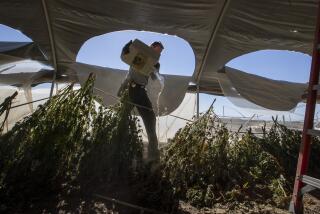Editorial: The lack of health research into marijuana makes it hard to tell people whether it is safe
In advance of the legalization of recreational marijuana sales on Jan. 1, there have been lots of debates over the details of the cannabis business. How many feet should pot shops be from schools or daycare centers? How many acres may a marijuana farmer cultivate? Who should be eligible for a license to sell and who shouldn’t?
But there’s been much less discussion over an equally important question raised by the end of prohibition in California: What is the right public health message to send to adults who can now legally buy and use marijuana? Voters overwhelmingly passed Proposition 64 last year and polls continue to show broad support for legalization. But just because marijuana is legal doesn’t mean it is risk-free.
With just days to go, public health agencies are scrambling to put together education campaigns before Jan. 1. But experts in the field say they face a big problem: There simply isn’t enough research into the impact of adult marijuana use to offer a lot of proven and practical health guidance.
The federal government’s restrictions on marijuana research serve no one — not the advocates of legalization, nor its opponents.
Earlier this year the National Academies of Sciences, Engineering and Medicine released the first comprehensive look at marijuana research in nearly two decades. A panel of experts analyzed more than 10,000 studies related to marijuana usage and cancer, mental health, accidents and a host of other health issues.
The report found some compelling evidence of risks, as well as some medicinal benefits. Long-term cannabis smokers were more likely to have respiratory problems. There was substantial evidence of a link between frequent marijuana use and the development of schizophrenia. Women who smoked pot while pregnant were more likely to have babies with lower birth weights. On the other hand, the drug was found to be effective in reducing chronic pain.
Nevertheless, despite those findings, the overwhelming conclusion of the report was that the effects of marijuana use are still largely a mystery and that the lack of evidence-based information poses a public health risk.
The problem is that marijuana is still illegal under federal law and is classified as a Schedule 1 drug with no medicinal value and a high potential for abuse. The federal government has strict limits on studies involving the drug, which makes it hard for researchers to get funding or to get access to the quantity and quality of cannabis needed for in-depth analysis. The result is that there is little conclusive evidence on marijuana’s effects — good or bad.
But as more and more states legalize medicinal and recreational use for adults, the lack of conclusive science leaves public health officials and regulators in a bind. They have a mandate to set limits on marijuana in order to protect the public and to provide accurate and unbiased information so that adults can make informed choices. But they can’t do their jobs well without more research.
For example, the National Academies report concluded there is “substantial evidence” that using marijuana before driving increases the risk of being involved in a crash. But there has been little research into what — if any — amount of marijuana use is considered safe for driving. Or how long a person should wait to drive after consuming cannabis. (The lack of research in this area is also a problem for law enforcement; there is not yet a reliable way to measure cannabis intoxication.)
There hasn’t been much research into the impact of the many new, highly concentrated cannabis products or into how different cannabis products — from edibles to lotions, balms and oils — affect different people. That increases risk to users. (Most cities and states that have allowed adult use of marijuana have seen an increase in emergency room visits for poisoning associated with edibles.) Nor has there been adequate study into what kinds of messages resonate with young people and adults, which makes it harder to design an effective health education campaign.
The federal government’s restrictions on marijuana research serve no one — not the advocates of legalization, nor its opponents. More than 40 states have legalized some form of cannabis for medical or recreational use, despite the lack of evidence-based information on its effects. Surely even the Trump Administration — which has been no friend to science — can see the value in having more research on the health impacts of marijuana. It should remove the drug from Schedule 1 designation. If it won’t act, Congress ought to take steps to allow more marijuana research.
Follow the Opinion section on Twitter @latimesopinion and Facebook
More to Read
A cure for the common opinion
Get thought-provoking perspectives with our weekly newsletter.
You may occasionally receive promotional content from the Los Angeles Times.










